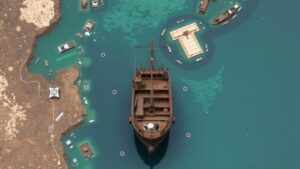Exploring Abandoned Coastal Beacon Towers for Maritime Artifact Discoveries
Exploring Abandoned Coastal Beacon Towers for Maritime Artifact Discoveries
Coastal beacon towers were once critical navigational aids, guiding maritime vessels to safety through treacherous waters. As advancements in technology rendered these towers obsolete, many have been left abandoned, creating unique opportunities for archaeological exploration. This research article delves into the significance of these structures, their historical contexts, and the artifacts that may be discovered through systematic exploration.
Historical Overview of Coastal Beacon Towers
Coastal beacons date back to ancient civilizations, where they served to warn ships of dangerous coastlines. The most notable examples include the Pharos of Alexandria, which was one of the Seven Wonders of the Ancient World, and the numerous lighthouse structures along the coasts of Europe and the Americas. In the United States, the establishment of the U.S. Lighthouse Board in 1852 standardized beacon tower construction, leading to the creation of iconic structures such as the Cape Hatteras Lighthouse in North Carolina. But, as GPS technology became widespread in the late 20th century, many of these historic towers were decommissioned. The National Oceanic and Atmospheric Administration (NOAA) reported in 2021 that nearly 20% of the original coastal beacons in the U.S. are no longer operational.
Significance of Abandoned Beacon Towers
These abandoned structures represent tangible links to maritime history. They serve as tangible reminders of past navigational methods and the economic activities that depended on safe coastal navigation. Exploring these towers can yield valuable historical artifacts such as:
- Original architectural components
- Navigational instruments
- Maritime cargo remnants
- Personal belongings of beacon keepers
For example, in 2020, a team of marine archaeologists in Massachusetts uncovered navigational charts dating back to the 19th century in the remnants of an old beacon tower on Cape Cod. Such findings not only contribute to the understanding of maritime navigation practices but also inform historical scholarship and preservation efforts.
Methodology for Exploration
The exploration of abandoned coastal beacon towers necessitates a systematic approach to ensure the preservation of both the structures and any artifacts found within. Key methodologies include:
- Site Survey and Mapping: Utilizing Geographic Information Systems (GIS) to map the location and condition of beacon towers prior to exploration.
- Documentation: Capturing photographs and detailed sketches to document the structural integrity and any observed artifacts.
- Excavation Techniques: Useing non-invasive digging methods, such as ground-penetrating radar, to locate buried artifacts without damaging the site.
These techniques align with the standards set by the Society for Historical Archaeology, which emphasizes the importance of ethical practices in archaeological investigations.
Case Studies of Artifact Discoveries
Several notable case studies illustrate the potential for significant discoveries at abandoned beacon towers:
- Ocracoke Island Lighthouse: In 2018, divers recovered parts of a kerosene lamp from the Ocracoke Island Lighthouse, shedding light on the operational practices of early 20th-century coastal navigation.
- Point Reyes Lighthouse: In 2015, an excavation revealed over 100 artifacts, including glass lenses and original machinery components, providing insight into the technological advancements of the time.
These case studies not only highlight the variety of artifacts that can be found but also emphasize the need for continued exploration and documentation of such historical sites.
Challenges in Exploration
Despite the potential for remarkable discoveries, several challenges can impede the exploration of abandoned beacon towers:
- Environmental Degradation: Many sites face erosion, vandalism, and environmental wear, complicating preservation efforts.
- Legal Restrictions: Some towers are located on private property or within protected areas, necessitating permissions that can delay access.
Addressing these challenges requires collaboration between archaeologists, local government authorities, and private stakeholders to ensure both access to sites and the preservation of cultural heritage.
Conclusion
The exploration of abandoned coastal beacon towers serves not only as an archaeological endeavor but also as a means to reconnect with maritime history. As stewards of our cultural heritage, it is imperative to engage in these explorations with a commitment to preserving knowledge for future generations. combination of historical significance, the potential for artifact discovery, and the challenges faced underscores the need for a balanced, systematic approach to these important maritime landmarks.
Actionable Takeaways
- Engage with local historical societies to learn about coastal beacon towers in your area.
- Consider joining archaeological workshops focused on maritime history and site exploration techniques.
- Advocate for the preservation of abandoned coastal structures to foster public interest in maritime heritage.



